
Bled is a town on Lake Bled in the Upper Carniolan region of northwestern Slovenia. It is the administrative seat of the Municipality of Bled. It is most notable as a popular tourist destination in the Upper Carniola region and in Slovenia as whole, attracting visitors from abroad too.

Sint-Pieters-Leeuw is a municipality in the province of Flemish Brabant, in the Flemish region of Belgium.
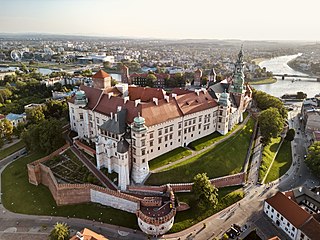
The Wawel Royal Castle and the Wawel Hill on which it sits constitute the most historically and culturally significant site in Poland. A fortified residency on the Vistula River in Kraków, it was established on the orders of King Casimir III the Great and enlarged over the centuries into a number of structures around an Italian-styled courtyard. It represents nearly all European architectural styles of the Medieval, Renaissance and Baroque periods.

Brdo Castle near Kranj, usually simply Brdo Castle, is an estate and a mansion in the Slovenian region of Upper Carniola west of the village of Predoslje, City Municipality of Kranj, northwest of Ljubljana. It is the Slovenian government's main venue for diplomatic meetings and other government-sponsored events.

Lake Bled is a lake in the Julian Alps of the Upper Carniolan region of northwestern Slovenia, where it adjoins the town of Bled. The area is a tourist destination. The lake is 35 km (22 mi) from Ljubljana International Airport and 55 km (34 mi) from the capital city, Ljubljana. Lake Bled is 4.2 km (2.6 mi) from the Lesce–Bled train station.

Windsor Castle is a royal residence at Windsor in the English county of Berkshire. It is strongly associated with the English and succeeding British royal family, and embodies almost a millennium of architectural history.

The Château de Montgilbert is a ruined medieval fortress located in the commune of Ferrières-sur-Sichon, 25 km to the south-east of Vichy in the Allier département of France.

The Château du Bernstein is a ruined castle in the commune of Dambach-la-Ville, in the Bas-Rhin département of France. It is situated at an altitude of 557 metres (1,827 ft).

Ljubljana Castle is a castle complex standing on Castle Hill above downtown Ljubljana, the capital of Slovenia. It is a key landmark of the town. Originally a medieval fortress, it was probably constructed in the 11th century and rebuilt in the 12th century. It acquired its present outline with an almost complete overhaul in the 15th century, whereas the majority of the buildings date to the 16th and 17th centuries. Initially a defense structure and since the first half of the 14th century the seat of the lords of Carniola, it was since the early 19th century used for various other purposes and today is used as a major cultural venue.

Tourbillon Castle is a castle in Sion in the canton of Valais in Switzerland. It is situated on a hill and faces the Basilique de Valère, located on the opposite hill.

Schloss Johannisburg is a schloss in the town of Aschaffenburg, in Franconia, in the state of Bavaria, Germany. It was erected between 1605 and 1614 by the architect Georg Ridinger for Johann Schweikhard von Kronberg, Prince Bishop of Mainz. Until 1803, it was the second residence of the Archbishop and Prince Elector of Mainz. It is constructed of red sandstone, the typical building material of the Spessart, the hills near Aschaffenburg.
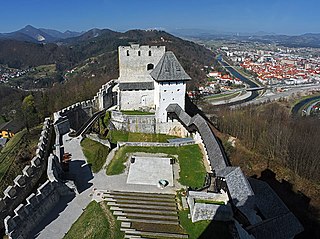
Celje Castle, also known as Celje Upper Castle or Old Castle, is a castle ruin in Celje, Slovenia, formerly the seat of the Counts of Celje. It stands on three hills to the southeast of Celje, where the river Savinja meanders into the Laško valley. Today, the castle is in the process of being restored. It was once the largest fortification on Slovenian territory.

Bogenšperk Castle is a 16th-century castle located in the Municipality of Šmartno pri Litiji in central Slovenia. It is best known for its association with the 17th-century scientist and natural historian Johann Weikhard von Valvasor, a fellow of the Royal Society in London.

Rapperswil Castle is a castle, built in the early 13th century by the House of Rapperswil, in the formerly independent city of Rapperswil.
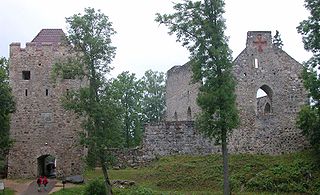
Sigulda Medieval Castle ruins are located on the edge of the Gauja valley in Latvia. The original castle was built in 1207 as a castellum type fortress, later rebuilt into a convent type building. The residence of the Land Marshal of the Livonian Order since 1432.
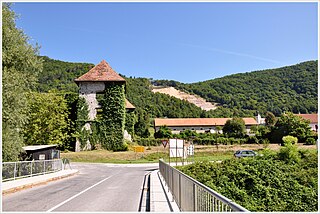
Soteska is a settlement on the left bank of the Krka River in the Municipality of Dolenjske Toplice in Slovenia. The area is part of the historical region of Lower Carniola. The municipality is now included in the Southeast Slovenia Statistical Region. Soteska includes the hamlet of Ključ southeast of the main settlement.

Lissingen Castle is a well-preserved former moated castle dating to the 13th century. It is located on the River Kyll in Gerolstein in the administrative district of Vulkaneifel in Rhineland-Palatinate, Germany. From the outside it appears to be a single unit, but it is a double castle; an estate division in 1559 created the so-called lower castle and upper castle, which continue to have separate owners. Together with Bürresheim and Eltz, it has the distinction among castles in the Eifel of never having been destroyed.
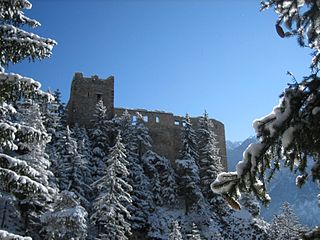
Belfort Castle is a ruined castle in the municipality of Brienz/Brinzauls of the Canton of Graubünden in Switzerland. It is a Swiss heritage site of national significance.

Tschanüff Castle is a ruined castle in the former municipality of Ramosch of the Canton of Graubünden in Switzerland. It is a Swiss heritage site of national significance.

The Château de Meung-sur-Loire is a former castle and episcopal palace in the commune of Meung-sur-Loire in the Loiret département of France.




























